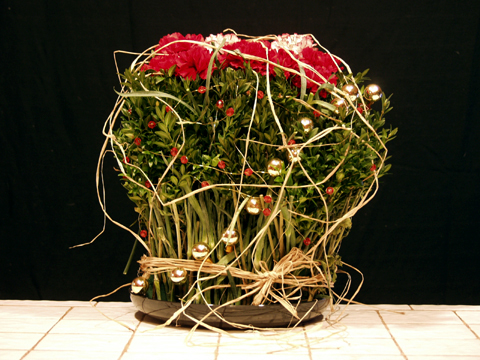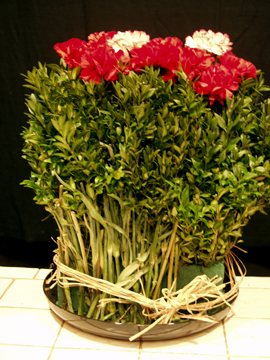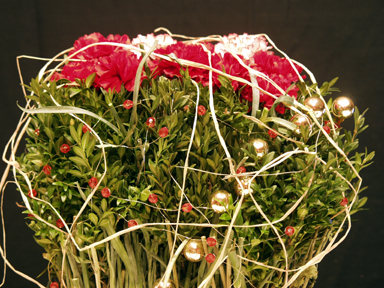|
Rittners School Of Floral Design
In Boston Presents....
How To Make A
Hedgerow Christmas Arrangement

Christmas designing is one area of floral art that is fascinating, for there are
so many themes, symbols, motifs and approaches that one can take! In our Six Month
Day Course, we spend several weeks exploring a wide variety of Christmas techniques. However, one
could easily spend six months alone, stylizing Christmas designs, and still have plenty of possibilities.
In this design we explore contemporary hedgerow effects in Christmas floral art. A hedgerow design is one patterned after
a garden hedgerow effect. It is considered a rather contemporary approach, and as you can see from the picture,
rather different.
Is this design for everyone? I don't think so. It is ideal for the person who is adventurous and who
enjoys a different kind of look in their Christmas floral art. Study if for a while though. If you are
conservative in your floral art tastes, the look actually may grow on you after a while!!
What You Will Need
Utility container
1 block of foam
Boxwood
Flower jewels
Nine or ten carnations
Raffia
Glass Ball Ornaments
 We start this design
by placing a block of foam into a container. The base that we
are using is a utility dish, meaning an inexpensive container. However,
you can use any container that you'd like. Cover the base with your
foliage. In this case we are using boxwood which is a very popular
green around the Christmas season. Boxwood lends itself very well to a hedgerow effect
for it is rather bushy and can be shaped relatively easily. It is a very good keeping
foliage as well. Make sure you add water to the foam on a regular
basis and you will find that this design will hold up fairly well. Alternatively if you are
trying this kind of styling at a different time of the year, consider Oregonia, which
gives a similar visual effect. Take care to place fairly long sized pieces as you create
your hedge. (Unless you want to make a short hedge!!) We start this design
by placing a block of foam into a container. The base that we
are using is a utility dish, meaning an inexpensive container. However,
you can use any container that you'd like. Cover the base with your
foliage. In this case we are using boxwood which is a very popular
green around the Christmas season. Boxwood lends itself very well to a hedgerow effect
for it is rather bushy and can be shaped relatively easily. It is a very good keeping
foliage as well. Make sure you add water to the foam on a regular
basis and you will find that this design will hold up fairly well. Alternatively if you are
trying this kind of styling at a different time of the year, consider Oregonia, which
gives a similar visual effect. Take care to place fairly long sized pieces as you create
your hedge. (Unless you want to make a short hedge!!)
After placing the foliage as shown in the photograph, add nine or ten carnations
to the top of the hedge. The flowers add a burst of color and contrast. We are using
carnations for they have great lasting quality. In addition, they come in the traditional
holiday colors such as red, peppermint, pink or white. However, other flowers such as
roses would work very nicely here. We are placing the stems of the carnations right
through the foliage so that they can get water from the foam. Alternatively we could
place them into water tubes.
Next we place a large number of stems around the base of the design.
The stems may be pinned in place. They are also held in place by wrapping and
tieing some raffia around them. The raffia tie is therefore both decorative and functional.
Notice that the stems are an illusion. Looking at the completed design we get the idea
that the stems are part of the boxwood and are holding up the foliage, when actually they are not.
However, they do look more interesting then the original boxwood stems which are rather stubby and are hidden by their
insertions into the foam.
 The design is nice
but rather plain looking, so let's jazz it up!!! The design is nice
but rather plain looking, so let's jazz it up!!!
Let's start by adding some flower jewelry. There are a number of items on the market
today, individual beads, beads attached to each other with wire, and even small imitation
gemstones, that may be collectively called "flower jewelry."
We are weaving some of these materials through the hedge, for contrast and interest.
The overall effect reminds us of a hedge in a garden with some Christmas lights attached.
To create a sense of dynamism and movement, let's add a few glass ornamental balls.
You notice them in this photograph in the upper right hand side of the design. However,
scroll upwards ( or downwards ) to the completed design and you will notice that we've
created a definite pattern with the glass balls. They are forming a gentle "Hogarth Curve"
from the base of the design, bringing our eyes from the bottom towards the top.

The problem of course
with a hedge, is that it is a rather static, vertical entity. By adding the flower
jewelry and by creating a counterpoint with the glass balls, we've added much, more
interest. We could stop at that point if we wanted to, but wait there's more!!!
Let's take a little more raffia and weave it through the entire design.
This adds but another counterpoint to the dynamics started by the flower jewelry and glass
balls. It also integrates the entire design, both top and bottom into a more comprehensive whole.
The effect becomes a more visually "busy" and dynamic piece.
Although we are using this approach for a "hedgerow" style, we could, of course, decorate our
hedgerow like any boxwood or Christmas tree. Conversely, we could use the same style of embellishment
shown here on a more tradtional miniature tree made with boxwood, balsam or other foliages associated
with the holiday season.
This kind of design can be made all the way around, or could be stylized
as a one sided piece, depending upon where it is to be displayed. If, for
example, we were to use this as a table centerpiece, we might want it to be
all the way around. If, on the other hand, it is to be placed up against a wall
it could be made more economically as a one sided piece.
It could be made using permanent botanicals if one wanted.
Consider also, the use of various filler materials for the hedge effect if
we wanted to consider the use of this style for other times of the year.
We hope that you really enjoyed this brief floral design lesson. At
Rittners Floral School in Boston we provide
floral design instruction that includes a wide range of different
styles and techniques. Please come and take one of our hands-on
workshop programs!!
Rittners Floral Education Center
returns you to our Floral Education Center.
Your Webmaster is Dr. Steve Rittner, who may be reached at Stevrt@tiac.net.
All photographs and text on
this page are Copyright - Rittners School,
and may not be reproduced, or used for any commercial purposes.
|